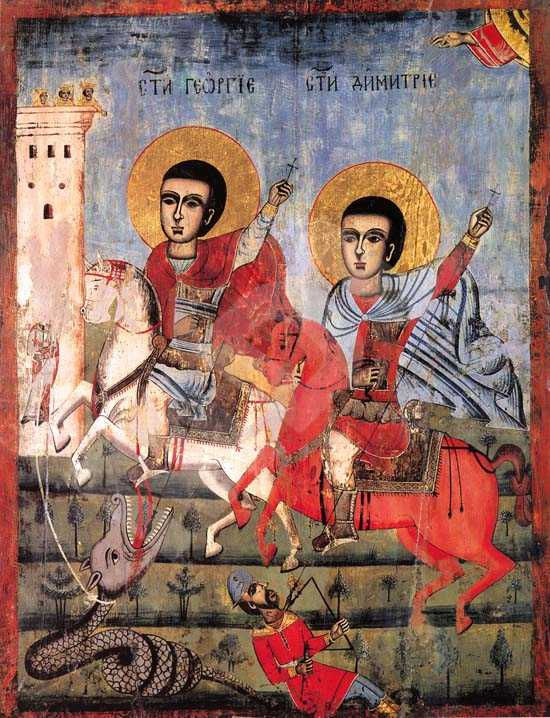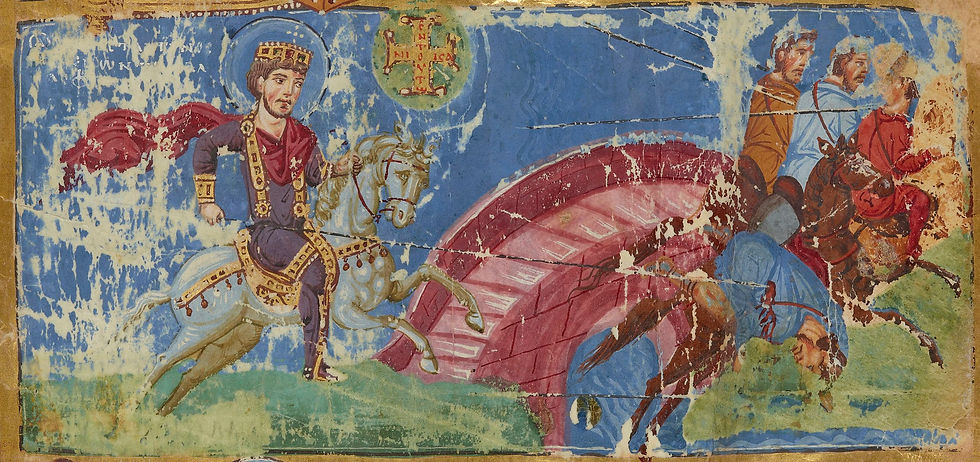The Ginger Saint of Constantinople
- Nila Nmc
- Apr 9, 2021
- 7 min read
Updated: Apr 10, 2021

Hello history lovers. I know I disappeared for a while, but I have been working on my Ph.D. thesis which I’ve started in January. Moreover, I’ve been working part-time so it was hard to dedicate further time to writing. Maybe my alibi is still not acceptable to you, but I’m back with another tale to make your day. These days, all I have in mind is the Roman, Medieval town of Naples together with its hinterlands and I would like to share a lot with my lovely audience, especially those who love Medieval Archaeology. However, I’ve decided to go the other way and tell a simple but captivating tale to whip up my audience as many of you, might be tired of academic papers and ‘college talk’.
This story is quite famous, and the majority of people may know about it, but I still would share it with you in my way. All of my close friends know that my favorite Byzantine saint is George. I even have a small icon of him (a gift from a Greek friend) on my desk. My admiration and love toward saint George are due to personal reasons but I’m sure you’re going to like him too after hearing this story.
The truth is that very little is known about the life of George and all we have mostly depended on traditional rumors and folklore. There are various versions but they all have something in common; George was of Cappadocian Greek descent with Christian parents. His father was killed due to his Christian faith as a Roman soldier while his mother was a Palestinian Christian from the city of Lod, 15 km southeast of Tel Aviv in Israel.
George himself served in the Roman army just like his father during the reign of Roman Emperor Diocletian, who was against Christians and persecuted thousands of innocent people because of their faith in Christ. Consequently, in 303 George was sentenced by him as he refused to recant his faith. Afterward, he was venerated as a military saint throughout the empire and later he became a megalomartyr among Christians.
This title is derived from the Byzantine Greek, meaning great martyr which was a classification of venerated saints in the church of Constantinople and later found its way to all Eastern Orthodox churches and also the Catholic ones. These martyrs were tortured to death and often performed miracles while they were alive. And so, Saint George was one of them. The bones of George are buried in his sarcophagus in the church of Saint George, located in his motherland, Lod, Israel. The current church was built in the 19th century on the site of the Byzantine basilica which was probably constructed during the 4th century.

There is a well-known legend about Saint George and the Dragon which was first recorded in the 11th century in a Gregorian source. According to this tradition, a fierce and dangerous dragon was exacerbating the safety of the city of Silene in Libya. To prevent this dragon from eating the citizens of Silene, people had to give two sheep each day to the dragon to fill him up. However, there were times with no available sheep, thus, they had to sacrifice a person who had to get elected by the citizens.
Luckily, Saint George passed through the city as the Roman army was in the area. At that time, the king’s daughter was selected to be sacrificed but George saved her by slaying the dragon with a lance. Owing to this miraculous victory, the king offered George golden coins and treasures as a reward although, George gave them all to the poor people of the city. Having seen this, the people of Silene converted their faith to Christianity and were all baptized.
Years later, at the height of its power in the 7th century, the Byzantine Roman Empire under Justinian the Great stretched northward to the Danube, westward by one and a half thousand miles from Constantinople to the far shores of the Mediterranean, southward by one and a half thousand miles to the upper reaches of the Blue Nile, and eastward by one thousand miles to the shores of the Caspian Sea. The strength and influence of the central Imperial government was strongest in Asia Minor and the southern half of the Balkan peninsula and inevitably diminished progressively toward its southernmost borders. At the far-distant borders, quasi-independent kingdoms and dukedoms paid homage to the central authority of the Empire but were far from being subservient vassal states. Even closer to home, some of the provinces on occasion rebelled overtly against Imperial rule and claimed total independence from their Byzantine overlords. Thus, Bulgarian Tsars, for example, intermittently claimed and exercised independent control for long periods over large areas of the Balkan peninsula.
There were corresponding cultural divergences between the metropolis of Constantinople and the cities of the border states and provinces. Christianity was the official religion throughout the Empire, but its cultural practices were far from uniform. We see this in religious art and architecture, as well as in liturgical practice. The iconography of St. George was no exception to this general rule, and in the outer provinces and semi-autonomous states, there were marked deviations from the formal pattern that characterized icons from the workshops of Constantinople, especially those of the later centuries of Empire. Even in some of the nearby Balkan provinces there were marked iconographic differences. The cult of the saint as martyr-warrior was just as strong there as it was in the metropolis, but distinct forms of representation arose and were perpetuated through succeeding centuries.
In Bulgaria and Dalmatia, an interesting and unusual iconographic variant developed, in which the warrior-saint is enthroned in a pose that can best be described as being ‘seated in majesty. This was a fairly early development, for there is a 10th-century example in an icon from the Bulgarian Monastery of Rila, the subject of a 40 st value of a series of Bulgarian postage stamps issued in 1968 on the 1000th anniversary of the Monastery.
In this icon, the Saint holds a sword across his breast, and unusually his mien is very stern, giving the impression that he is seated in judgment. A 16th-century Bulgarian icon from Plovdiv, now in the National Gallery in Sofia, shows a more benevolent enthroned St. George, holding a lance in his right hand. Its motif is the angelic crowning of the Saint, a common theme in icons of the post Comnenian era in the border dependencies of Byzantium. This icon also has also been depicted on a Bulgarian stamp, issued in 1969.

Another unusual theme is found in an icon of the Saint in the Church of St. George in Strega in the Republic of Macedonia. This depicts the ‘Raising of Glicarius’ oxen’, a miracle from the apocryphal Passion of the Saint which led to St. George becoming the patron Saint of farmers.

The cult of St. George was also strong in the Byzantine provinces which today make up modern Romania, especially the provinces of Moldavia, Wallachia, and Transylvania. During the last stages of fragmentation of the Empire, when the Turks were penetrating northwards into the European heartland, St. George was invoked in those areas as the protector of Christian people, and according to Scott Fox, the Moldavians made him their patron saint.
The most impressive evidence of his cult is to be found in the celebrated ‘painted’ churches of Moldavia, which are unique in the Christian world, being covered externally with frescoes that have survived many centuries of exposure to the elements. Nearly a dozen such Moldavian ‘painted’ churches, with external frescoes executed during the first half of the 16th century, still remain in excellent condition.

St. George is prominent in several of these. A fairly conventional representation of the Saint slaying the dragon appears on the south face of the porch pillar of the monastery church of Moldavita, which was built by Petru Rares, Duke of Moldavia, in 1532, and was painted five years later. The monastery church of Arbore, built by Luca Arbore, Governor of Suceava principality and Commander in chief of the army, was built in 1502 and was decorated in 1541 by a noted artist called Dragos. The outer walls of this church carry a cycle of paintings depicting a most unusual variant of the story of St. George. In this, the Saint was not martyred by Diocletian, as told in the famous stories of his ‘Passion’. Instead, the Emperor succumbed to his exhortations and was finally converted to the Christian faith. Perhaps the painter of this cycle confused Diocletian with the King whose daughter was rescued from the dragon in the Golden Legend story, and who was subsequently baptized as a Christian.
To conclude this, one may well ask why so many fascinating variants of the iconography of St. George are found on the ‘Borders of Byzantium’, but not in the heartland of Byzantium, especially in the city of Constantinople itself. For example, why do we not come across the variant which depicts Diocletian instead of the dragon, in icons from the ateliers of Constantinople? The full story of the Diocletian persecution, the martyrdom of St. George under his cruel edicts against the Christians, and the subsequent liberation of the Church by Constantine derives not from the peripheral territories, but from the area around central Byzantium, where Constantine reigned. It was from here that accounts of the Diocletian persecution were carried to outlying provinces and kingdoms by those who first brought the faith. Whether or not St. Nina was a refugee from the Diocletian persecution, the date of her arrival in Georgia certainly suggests that she brought with her the full story of that persecution, and also probably the story of St. George. These same stories would similarly have been taken south by Frumentius from his home city of Tyre, in Syria, and by the Coptic missionaries who followed him to spread the faith in Ethiopia, and similarly by those missionaries who took it northwards to Bulgaria.
It is therefore difficult to imagine why such elements of the story of St. George should have been selectively excluded from the iconography of the church in Constantinople in the early centuries. But perhaps it is wrong to assume that these elements were never a part of the iconography of the Saint in the metropolitan center. It is possible that they were in fact originally an integral part of the iconography of the Saint throughout Byzantium, but that they disappeared in the metropolitan heartland during the century-long rule of the iconoclasts, while still surviving in outlying provinces and kingdoms such as Bulgaria, Georgia, and Ethiopia.




Comments